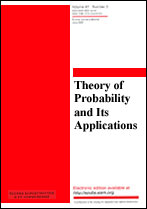|
|
Teoriya Veroyatnostei i ee Primeneniya, 1963, Volume 8, Issue 1, Pages 102–108
(Mi tvp4652)
|
 |
|
 |
Short Communications
Statistical Investigation of Russian Dolnik Trimeter
M. L. Gasparov
Moscow
Abstract:
Russian dolnik is the kind of verse with three metrical accents and two interaccentual intervals of 1–2 syllables. Four rhythmical elements of this verse are investigated in this paper I) the arrangement of stresses (different combinations of accents and interaccentual intervals); II) unstressed beginnings of lines (anacrusis); III) the arrangement of word-boundaries; IV) additional accents on the anacrusis. All the empirical data are compared with the characteristics theoretically calculated by the theorem of multiplication of the probabilities (the method of B. Tomashevskii with the corrections of A. N. Kolmogorov). The comparison shows that rhythmical elements III and IV nearly follow the natural tendencies of language, and only elements I and II display some specifical rhythmical tendencies of verse. There are three such tendencies in the evolution of dolnik. a) isolating tendency (dolnik avoids rhythmical forms in common with other meters), b) isosyllabic tendency, c) anapestical tendency. The interaction of these tendencies forms three principal types of dolnik trimeter by Russian poets "Esenin type", "Gumilev type" "Tsvetaeva type".
Received: 20.09.1961
Revised: 10.07.1962
Citation:
M. L. Gasparov, “Statistical Investigation of Russian Dolnik Trimeter”, Teor. Veroyatnost. i Primenen., 8:1 (1963), 102–108; Theory Probab. Appl., 8:1 (1963), 96–102
Linking options:
https://www.mathnet.ru/eng/tvp4652 https://www.mathnet.ru/eng/tvp/v8/i1/p102
|


| Statistics & downloads: |
| Abstract page: | 284 | | Full-text PDF : | 303 |
|




 Contact us:
Contact us: Terms of Use
Terms of Use
 Registration to the website
Registration to the website Logotypes
Logotypes








 Citation in format
Citation in format 